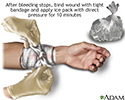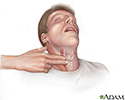Recognizing medical emergencies
Medical emergencies - how to recognize them
Information
According to the American College of Emergency Physicians, the following are warning signs of a medical emergency:
-
Bleeding
that will not stop
Bleeding
Bleeding is the loss of blood. Bleeding may be:Inside the body (internally) Outside the body (externally)Bleeding may occur:Inside the body when blo...
 ImageRead Article Now Book Mark Article
ImageRead Article Now Book Mark Article -
Breathing problems (
difficulty breathing
,
shortness of breath
)
Difficulty breathing
Breathing difficulty may involve:Difficult breathingUncomfortable breathingFeeling like you are not getting enough air
 ImageRead Article Now Book Mark Article
ImageRead Article Now Book Mark ArticleShortness of breath
Breathing difficulty may involve:Difficult breathingUncomfortable breathingFeeling like you are not getting enough air
 ImageRead Article Now Book Mark Article
ImageRead Article Now Book Mark Article -
Change in mental status
(such as unusual behavior,
confusion
, difficulty arousing)
Change in mental status
Confusion is the inability to think as clearly or quickly as you normally do. You may feel disoriented and have difficulty paying attention, remembe...
 ImageRead Article Now Book Mark Article
ImageRead Article Now Book Mark ArticleConfusion
Confusion is the inability to think as clearly or quickly as you normally do. You may feel disoriented and have difficulty paying attention, remembe...
 ImageRead Article Now Book Mark Article
ImageRead Article Now Book Mark Article -
Chest pain
Chest pain
Chest pain is discomfort or pain that you feel anywhere along the front of your body between your neck and upper abdomen.
 ImageRead Article Now Book Mark Article
ImageRead Article Now Book Mark Article - Choking
-
Coughing up or
vomiting blood
Vomiting blood
Vomiting blood is regurgitating (throwing up) contents of the stomach that contains blood. Vomited blood may appear either a bright red or dark red c...
Read Article Now Book Mark Article -
Fainting
or
loss of consciousness
Fainting
Fainting is a brief loss of consciousness due to a drop in blood flow to the brain. The episode most often lasts less than a couple of minutes and y...
Read Article Now Book Mark ArticleLoss of consciousness
Unconsciousness is when a person is unable to respond to people and activities. Doctors often call this a coma or being in a comatose state. Other c...
 ImageRead Article Now Book Mark Article
ImageRead Article Now Book Mark Article - Feeling of committing suicide or murder
- Head or spine injury
-
Severe or persistent
vomiting
Vomiting
Nausea is feeling an urge to vomit. It is often called "being sick to your stomach. "Vomiting or throwing-up is forcing the contents of the stomach ...
 ImageRead Article Now Book Mark Article
ImageRead Article Now Book Mark Article - Sudden injury due to a motor vehicle accident, burns or smoke inhalation, near drowning, deep or large wound, etc.
- Sudden, severe pain anywhere in the body
-
Sudden
dizziness
,
weakness
, or change in vision
Dizziness
Dizziness is a term that is often used to describe 2 different symptoms: lightheadedness and vertigo. Lightheadedness is a feeling that you might fai...
 ImageRead Article Now Book Mark Article
ImageRead Article Now Book Mark Article - Swallowing a poisonous substance
-
Upper
abdominal pain
or pressure
Abdominal pain
Abdominal pain is pain that you feel anywhere between your chest and groin. This is often referred to as the stomach region or belly.
 ImageRead Article Now Book Mark Article
ImageRead Article Now Book Mark Article
BE PREPARED
- Determine the location and quickest route to the nearest emergency department before an emergency happens.
- Keep emergency phone numbers posted by the phone. Everyone in your household, including children, should know when and how to call these numbers. These numbers include: fire department, police department, poison control center, ambulance center, your doctors' phone numbers, contact numbers of neighbors or nearby friends or relatives, and work phone numbers.
- Know at which hospital(s) your doctor practices and, if practical, go there in an emergency.
- Wear a medical identification tag if you have a chronic condition or look for one on a person who has any of the symptoms mentioned.
- Get a personal emergency response system if you are elderly, especially if you live alone.
WHAT TO DO IF SOMEONE NEEDS HELP
- Remain calm, and call your local emergency number (such as 911).
-
Start
CPR
(cardiopulmonary resuscitation) or rescue breathing, if necessary and if you know the proper technique.
CPR
CPR stands for cardiopulmonary resuscitation. It is an emergency lifesaving procedure that is done when someone's breathing or heartbeat has stopped...
Read Article Now Book Mark Article -
Place a semiconscious or
unconscious
person in the recovery position until the ambulance arrives. DO NOT move the person, however, if there has been or may have been a neck injury.
Unconscious
Unconsciousness is when a person is unable to respond to people and activities. Doctors often call this a coma or being in a comatose state. Other c...
 ImageRead Article Now Book Mark Article
ImageRead Article Now Book Mark Article
Upon arriving at an emergency room, the person will be immediately evaluated. Life- or limb-threatening conditions will be treated first. People with conditions that are not life- or limb-threatening may have to wait.
CALL YOUR LOCAL EMERGENCY NUMBER (SUCH AS 911) IF:
-
The person's condition is life-threatening (for example, the person is having a
heart attack
or
severe allergic reaction
)
Heart attack
Most heart attacks are caused by a blood clot that blocks one of the coronary arteries. The coronary arteries bring blood and oxygen to the heart. ...
 ImageRead Article Now Book Mark Article
ImageRead Article Now Book Mark ArticleSevere allergic reaction
Anaphylaxis is a life-threatening type of allergic reaction.
 ImageRead Article Now Book Mark Article
ImageRead Article Now Book Mark Article - The person's condition could become life-threatening on the way to the hospital
- Moving the person could cause further injury (for example, in case of a neck injury or motor vehicle accident)
- The person needs the skills or equipment of paramedics
- Traffic conditions or distance might cause a delay in getting the person to the hospital
References
Marx JA, Hockberger RS, Walls RM, et al, eds. Rosen's Emergency Medicine: Concepts and Clinical Practice . 8th ed. Philadelphia, PA: Elsevier Saunders; 2014:chap 190.
-
Stopping bleeding with direct pressure - illustration
Bleeding from most injuries can be stopped by applying direct pressure to the injury. This keeps from cutting off the blood supply to the affected limb.
Stopping bleeding with direct pressure
illustration
-
Stopping bleeding with a tourniquet - illustration
When there is severe bleeding where a major artery has been severed, pressure may be insufficient and a tourniquet may be necessary. Tourniquets are an effective way of stopping bleeding from an extremity. They do, however, stop circulation to the affected extremity and should ONLY be used when other methods, such as pressure dressings, have failed (or are likely to fail). Pressure from tourniquets must be relieved periodically to prevent damage to the tissue from lack of oxygen.
Stopping bleeding with a tourniquet
illustration
-
Stopping bleeding with pressure and ice - illustration
Bleeding from most injuries can be stopped by applying direct pressure to the injury. This keeps from cutting off the blood supply to the affected limb. When there is severe bleeding, where a major artery has been severed, pressure may be insufficient and a tourniquet may be necessary.
Stopping bleeding with pressure and ice
illustration
-
Neck pulse - illustration
To measure the pulse on the neck, place the index and middle finger just to the side of the Adam's apple, in the soft hollow area. This pulse is felt in the common carotid artery.
Neck pulse
illustration
-
Stopping bleeding with direct pressure - illustration
Bleeding from most injuries can be stopped by applying direct pressure to the injury. This keeps from cutting off the blood supply to the affected limb.
Stopping bleeding with direct pressure
illustration
-
Stopping bleeding with a tourniquet - illustration
When there is severe bleeding where a major artery has been severed, pressure may be insufficient and a tourniquet may be necessary. Tourniquets are an effective way of stopping bleeding from an extremity. They do, however, stop circulation to the affected extremity and should ONLY be used when other methods, such as pressure dressings, have failed (or are likely to fail). Pressure from tourniquets must be relieved periodically to prevent damage to the tissue from lack of oxygen.
Stopping bleeding with a tourniquet
illustration
-
Stopping bleeding with pressure and ice - illustration
Bleeding from most injuries can be stopped by applying direct pressure to the injury. This keeps from cutting off the blood supply to the affected limb. When there is severe bleeding, where a major artery has been severed, pressure may be insufficient and a tourniquet may be necessary.
Stopping bleeding with pressure and ice
illustration
-
Neck pulse - illustration
To measure the pulse on the neck, place the index and middle finger just to the side of the Adam's apple, in the soft hollow area. This pulse is felt in the common carotid artery.
Neck pulse
illustration
Review Date: 1/13/2015
Reviewed By: Jacob L. Heller, MD, MHA, emergency medicine, Virginia Mason Medical Center, Seattle, WA. Also reviewed by David Zieve, MD, MHA, Isla Ogilvie, PhD, and the A.D.A.M. Editorial team.




